Learning Objectives
By the end of this section, you will be able to:
Identify the following muscles and give their origins, insertions, actions and innervations:
- Appendicular muscles of the pelvic girdle and lower limbs
APPENDICULAR MUSCLES OF THE PELVIC GIRDLE AND LOWER LIMBS
The appendicular muscles of the lower body position and stabilize the pelvic girdle, which serves as a foundation for the lower limbs. Comparatively, there is much more movement at the pectoral girdle than at the pelvic girdle. There is very little movement of the pelvic girdle because of its connection with the sacrum at the base of the axial skeleton and because the deep acetabulum provides a stable point of articulation with the head of the femur. The pelvic girdle’s lack of range of motion allows it to stabilize and support the body. The body’s center of gravity is in the area of the pelvis. If the center of gravity were not to remain fixed, standing up would be difficult. Therefore, what the leg muscles lack in range of motion and versatility, they make up for in size and power, facilitating the body’s stabilization, posture, and movement.
Gluteal Region Muscles That Move the Thigh
Most muscles that insert on the femur (the thigh bone) and move it, originate on the pelvic girdle. The major flexors of the hip are the psoas major and iliac which make up the iliopsoas group. Some of the largest and most powerful muscles in the body are the gluteal muscles or gluteal group. The gluteus maximus, one of the major extensors of the thigh at the hip, is the largest; deep to the gluteus maximus is the gluteus medius, and deep to the gluteus medius is the gluteus minimus, the smallest of the trio (Figure 11.4.22 and Figure 11.4.23).
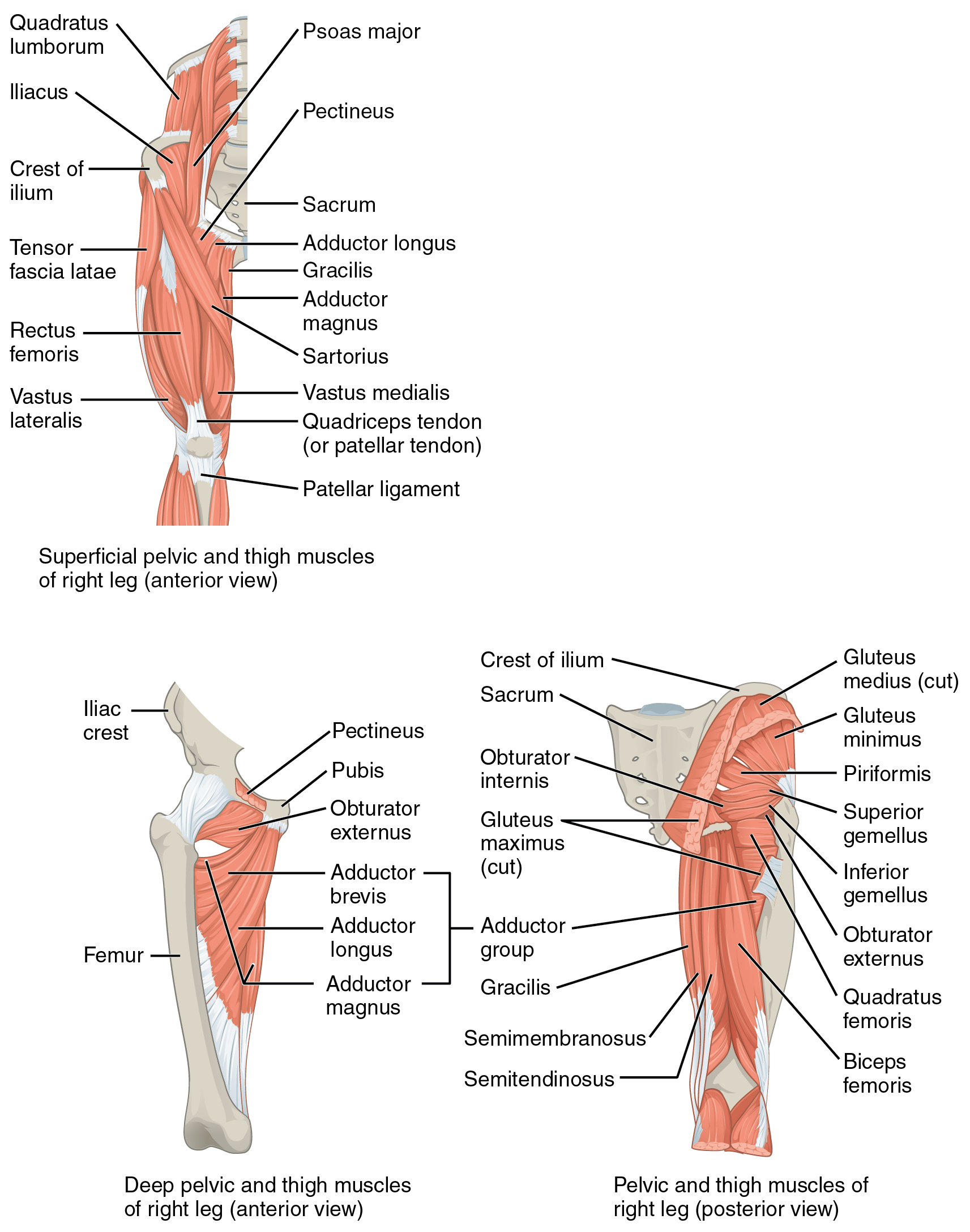
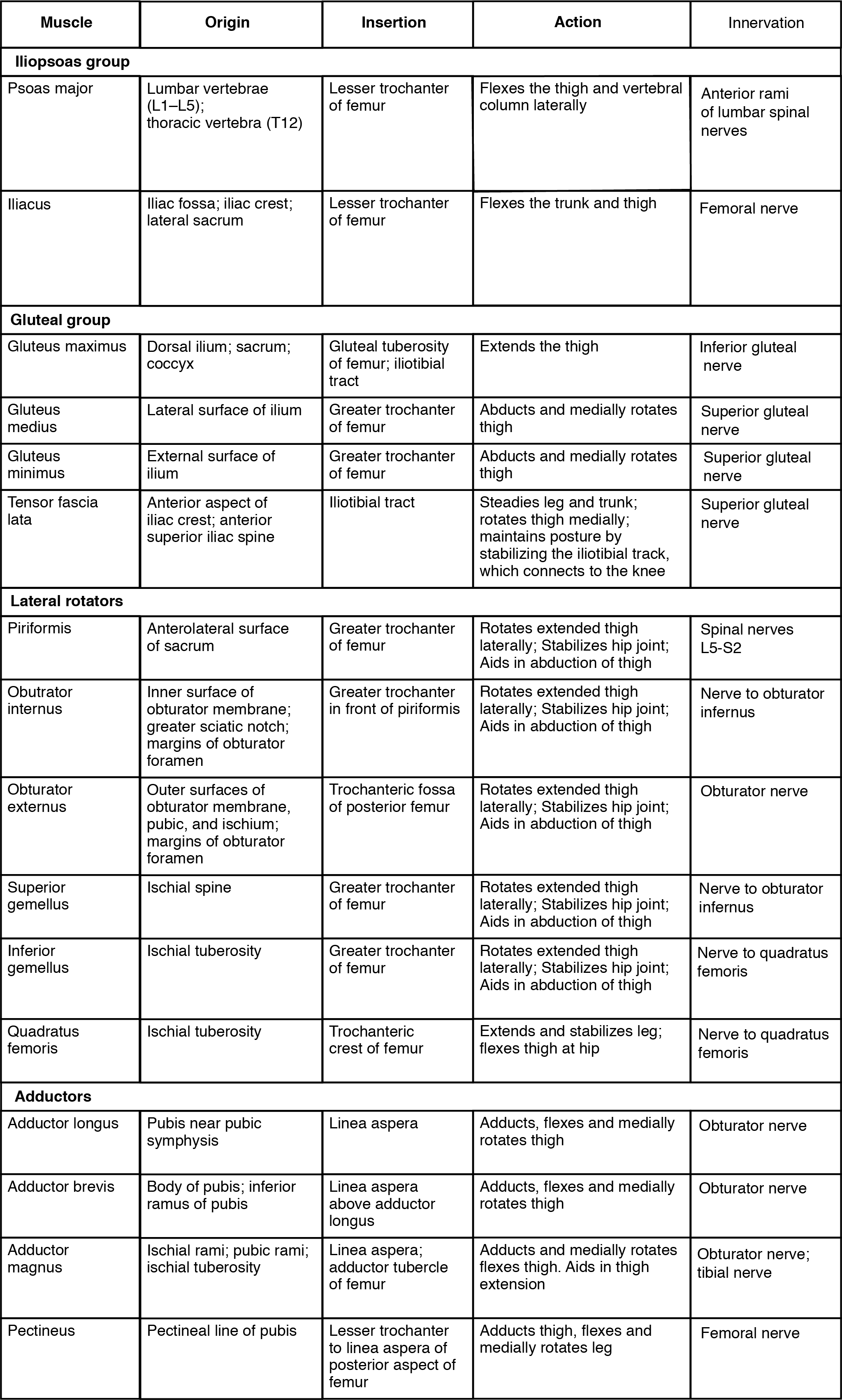
The tensor fascia latae is a thick, squarish muscle in the superior aspect of the lateral thigh. It acts as a synergist of the gluteus medius and iliopsoas in flexing and abducting the thigh. It also helps stabilize the lateral aspect of the knee by pulling on the iliotibial tract (band), making it taut. Deep to the gluteus maximus, the piriformis, obturator internus, obturator externus, superior gemellus, inferior gemellus, and quadratus femoris laterally rotate the thigh at the hip.
Deep fascia in the thigh separates it into medial, anterior, and posterior compartments. The muscles in the medial compartment of the thigh responsible for adducting the femur at the hip are the adductor group including the adductor longus, adductor brevis, and adductor magnus which all adduct and medially rotate the thigh. The adductor longus also flexes the thigh, whereas the adductor magnus extends it. Like the adductor longs, the pectineus adducts and flexes the femur at the hip. The pectineus is located in the femoral triangle, which is formed at the junction between the hip and the leg and includes the femoral nerve, the femoral artery, the femoral vein, and the deep inguinal lymph nodes. The strap-like gracilis adducts the thigh in addition to flexing the leg at the knee
Thigh Muscles That Move the Femur, Tibia, and Fibula
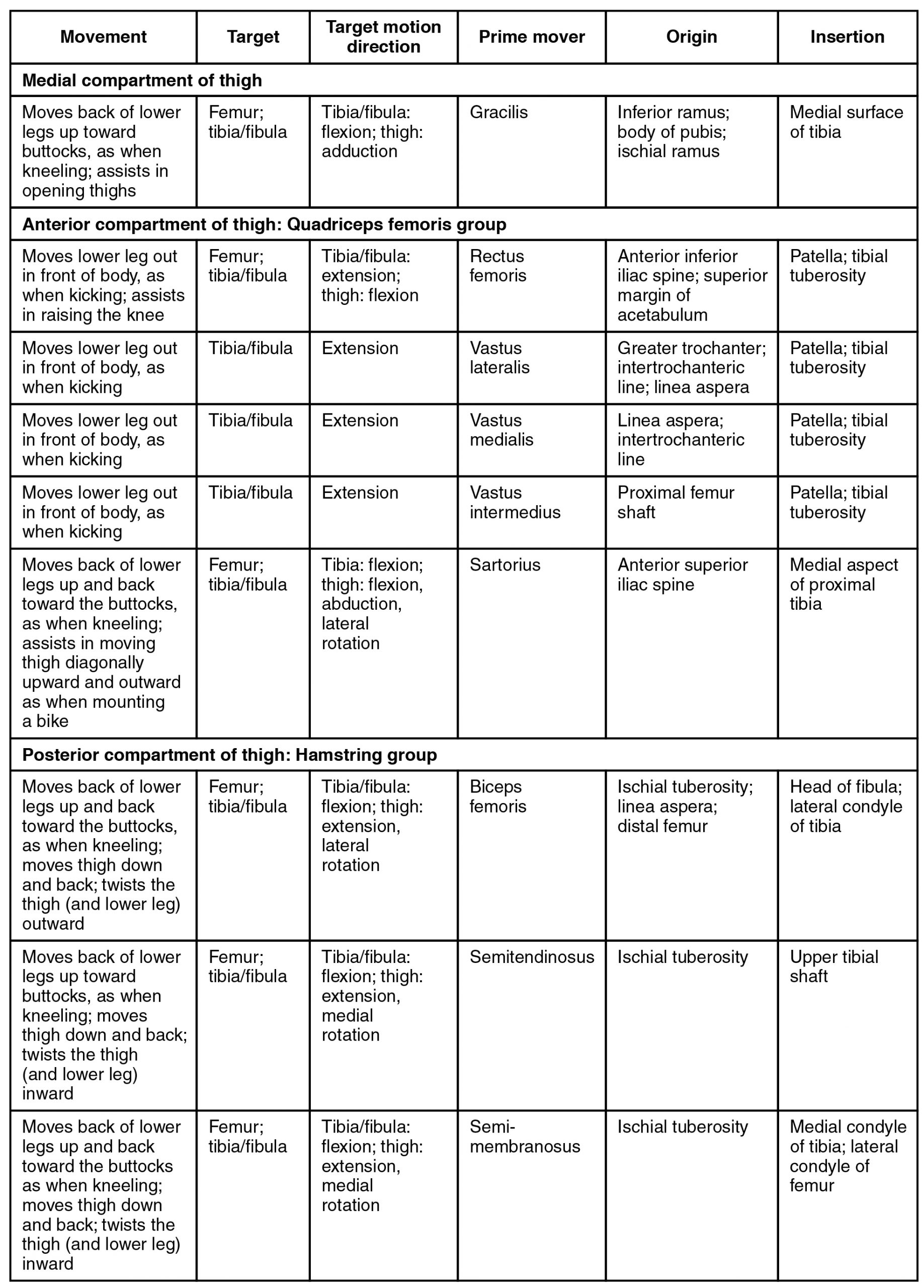
The muscles of the anterior compartment of the thigh flex the thigh and extend the leg. This compartment contains the quadriceps femoris group, which is comprised of four muscles that extend the leg and stabilize the knee. Within the compartment the rectus femoris is on the anterior aspect of the thigh, the vastus lateralis is on the lateral aspect of the thigh, the vastus medialis is on the medial aspect of the thigh, and the vastus intermedius is between the vastus lateralis and vastus medialis and deep to the rectus femoris. The tendon common to all four is the quadriceps tendon (patellar tendon), which inserts into the patella and continues below it as the patellar ligament. The patellar ligament attaches to the tibial tuberosity. In addition to the quadriceps femoris, the sartorius is a band-like muscle that extends from the anterior superior iliac spine to the medial side of the proximal tibia. This versatile muscle flexes the leg at the knee and flexes, abducts, and laterally rotates the thigh at the hip. This muscle allows us to sit cross-legged.
The posterior compartment of the thigh includes muscles that flex the leg and extend the thigh. The three long muscles on the back of the thigh are the hamstring group, which flexes the knee. These are the biceps femoris, semitendinosus, and semimembranosus. The tendons of these muscles form the upper border of the popliteal fossa, the diamond-shaped space at the back of the knee.
Muscles That Move the Feet and Toes
Similar to the thigh muscles, the muscles of the leg are divided by deep fascia into compartments, although the leg has three: anterior, lateral, and posterior.
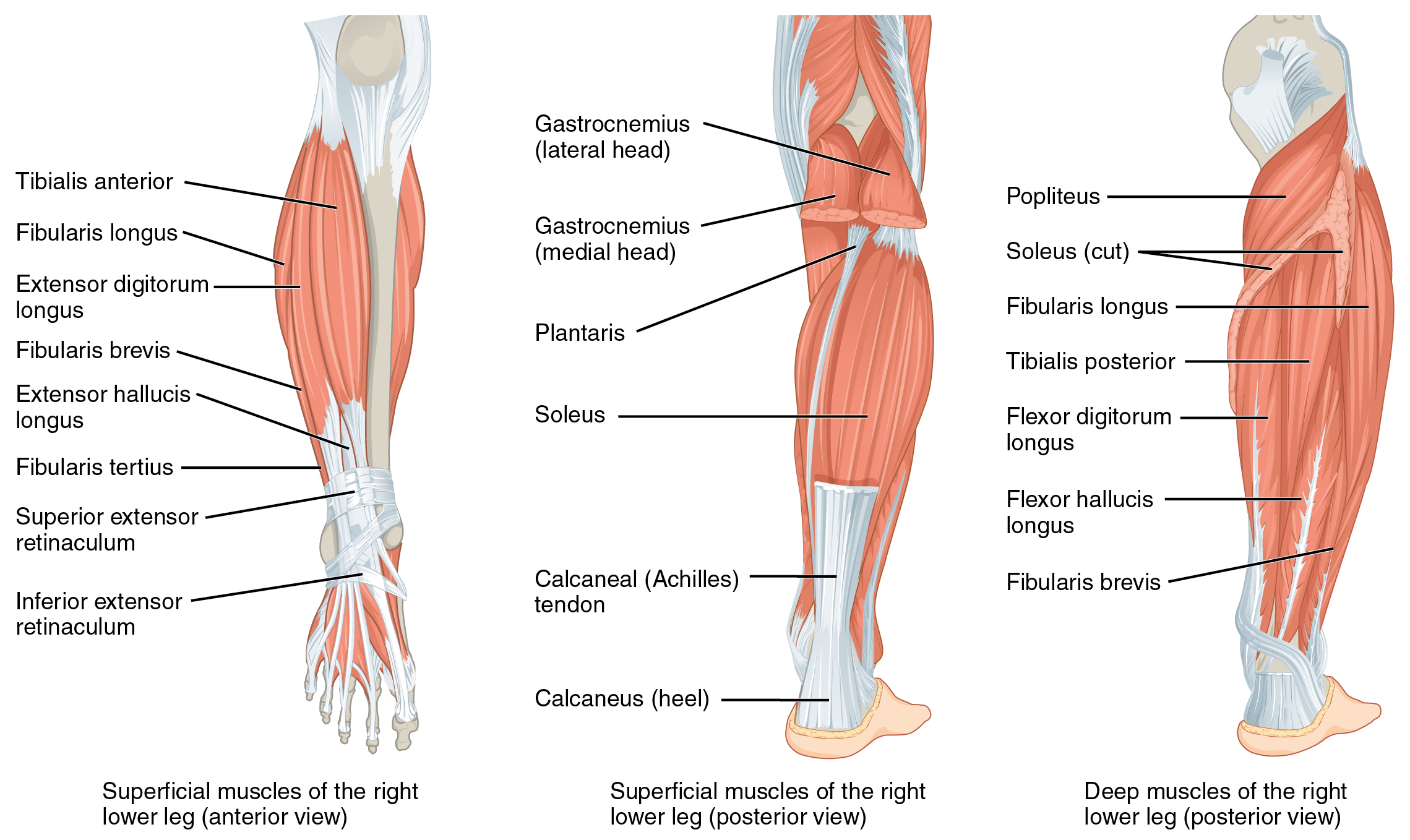
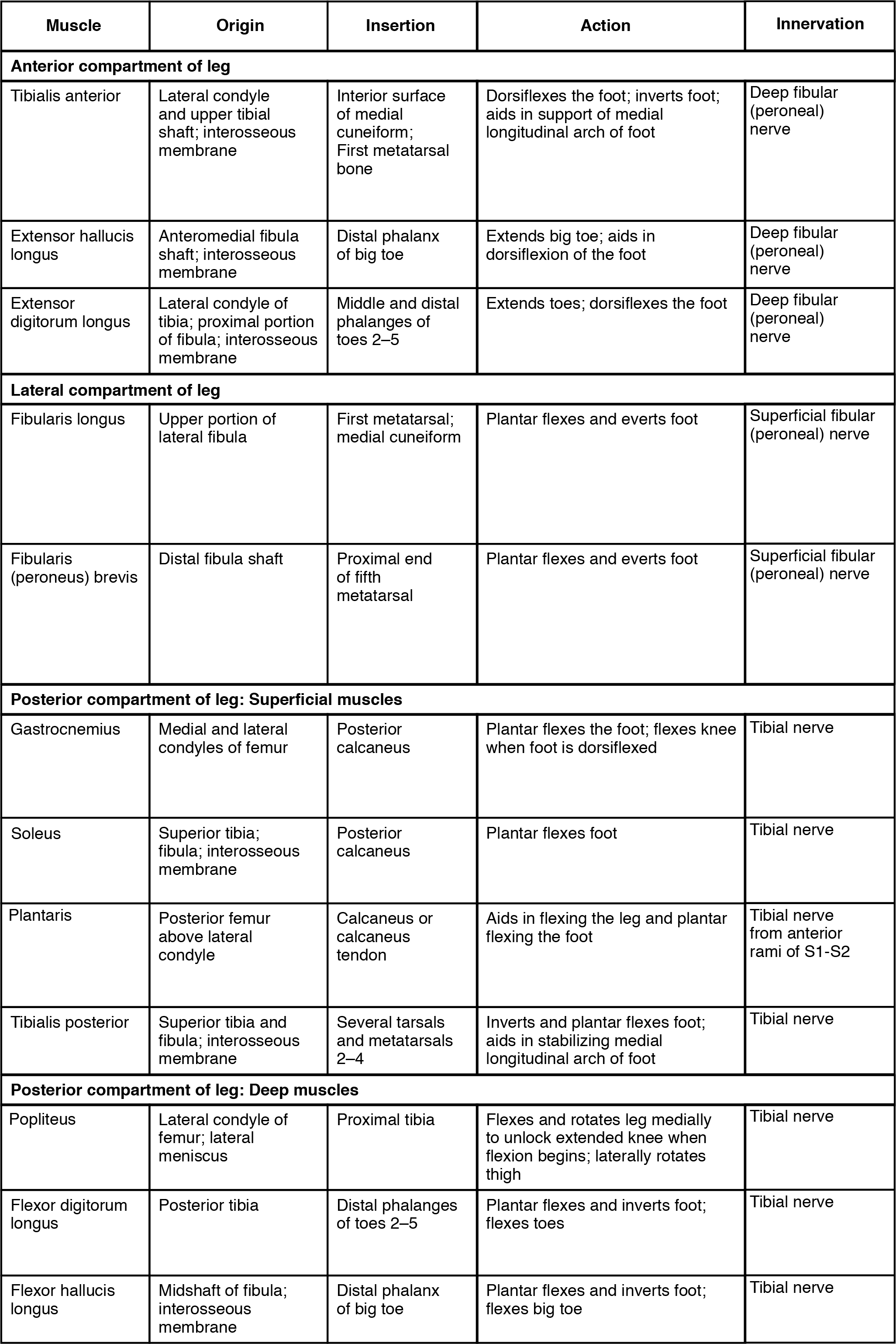
The muscles in the anterior compartment of the leg all contribute to dorsiflexion: the tibialis anterior, a long and thick muscle on the lateral surface of the tibia, the extensor hallucis longus, deep under it, and the extensor digitorum longus, lateral to it. The fibularis tertius, a small muscle that originates on the anterior surface of the fibula, is associated with the extensor digitorum longus and sometimes fused to it, but is not present in all people. Thick bands of connective tissue called the superior extensor retinaculum (transverse ligament of the ankle) and the inferior extensor retinaculum, hold the tendons of these muscles in place during dorsiflexion.
The lateral compartment of the leg includes two muscles which contribute to eversion and plantar flexion: the fibularis longus (peroneus longus) and the fibularis brevis (peroneus brevis). The superficial muscles in the posterior compartment of the leg all insert onto the calcaneal tendon (Achilles tendon), a strong tendon that inserts into the calcaneal bone of the ankle, all contribute to plantar flexion. The muscles in this compartment are large and strong and keep humans upright. The most superficial and visible muscle of the calf is the gastrocnemius. Deep to the gastrocnemius is the wide, flat soleus. The plantaris runs obliquely between the two; some people may have two of these muscles, whereas no plantaris is observed in about seven percent of other cadaver dissections. The plantaris tendon is a desirable substitute for the fascia lata in hernia repair, tendon transplants, and repair of ligaments. There are four deep muscles in the posterior compartment of the leg as well: the popliteus, flexor digitorum longus, flexor hallucis longus, and tibialis posterior all contribute to plantar flexion or inversion of the foot.
The foot also has intrinsic muscles, which originate and insert within it (similar to the intrinsic muscles of the hand). These muscles primarily provide support for the foot and its arch, and contribute to movements of the toes (Figure 11.4.27 and Figure 11.4.28). The principal support for the longitudinal arch of the foot is a deep fascia called plantar aponeurosis, which runs from the calcaneus bone to the toes (inflammation of this tissue is the cause of “plantar fasciitis,” which can affect runners. The intrinsic muscles of the foot include the extensor digitorum brevis on the dorsal aspect and a plantar group, which consists of four layers.
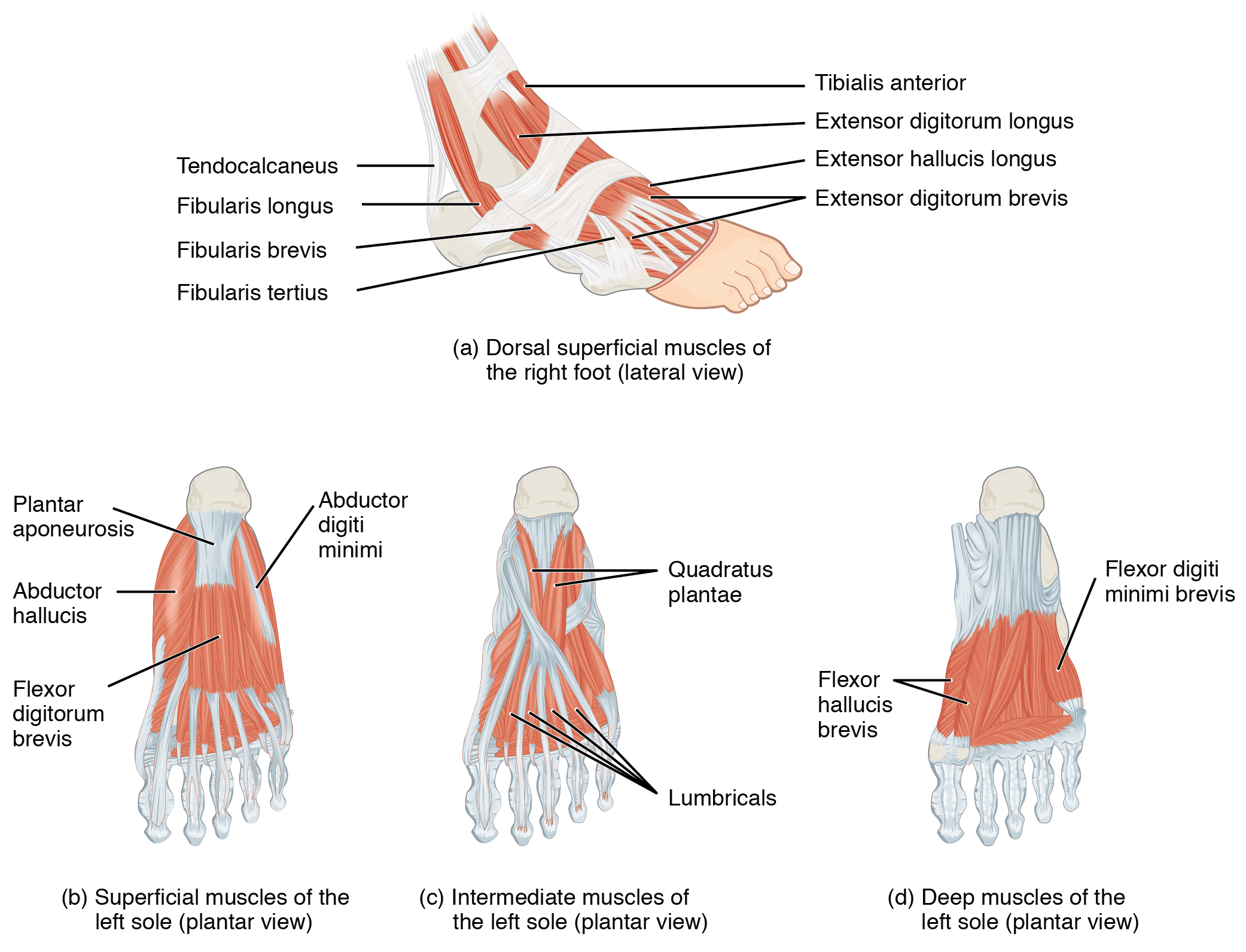
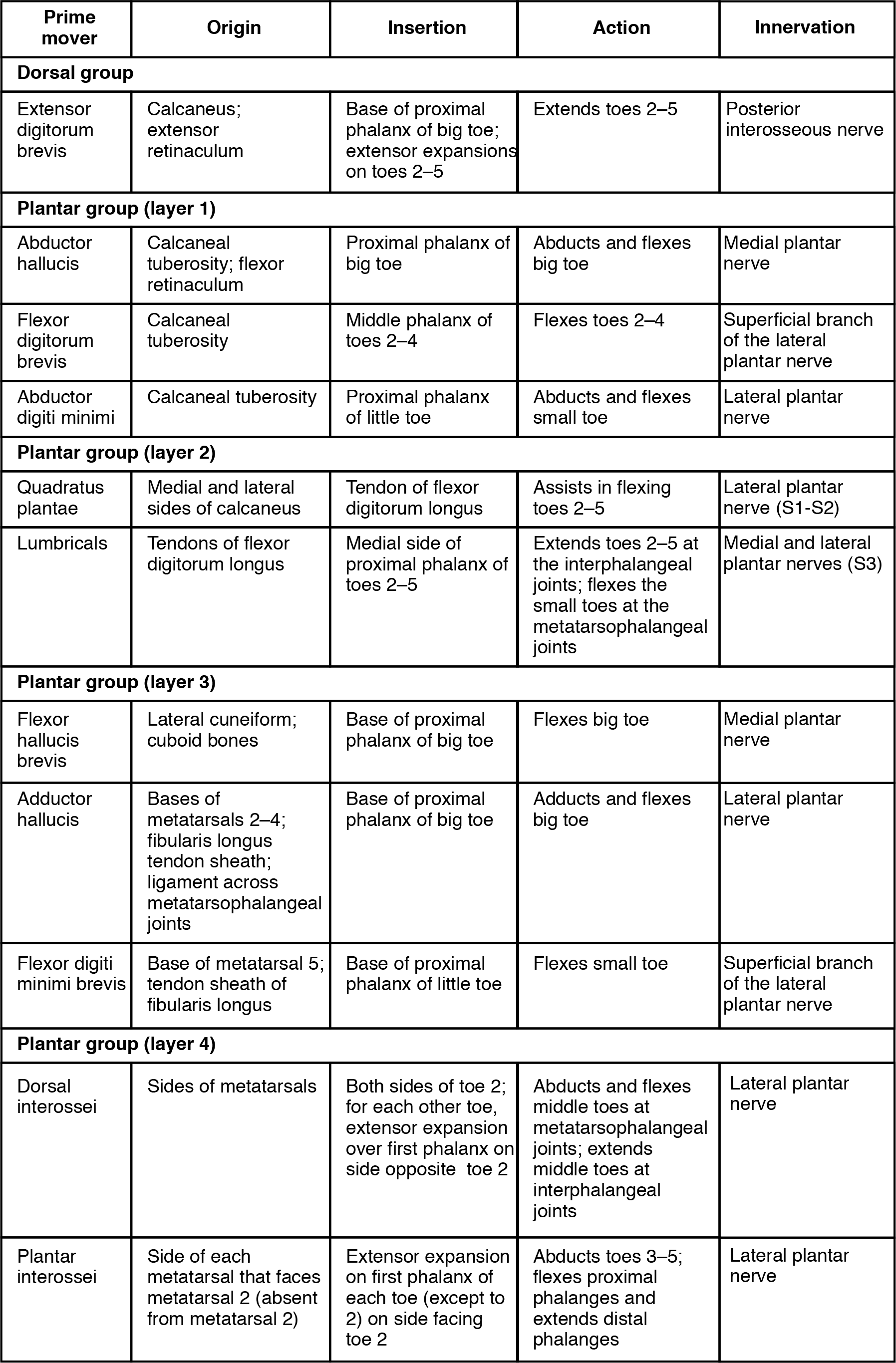
Chapter Review
The pelvic girdle attaches the legs to the axial skeleton. The hip joint is where the pelvic girdle and the leg come together. The hip is joined to the pelvic girdle by many muscles. In the gluteal region, the psoas major and iliacus form the iliopsoas. The large and strong gluteus maximus, gluteus medius, and gluteus minimus extend and abduct the femur. Along with the gluteus maximus, the tensor fascia lata muscle forms the iliotibial tract. The lateral rotators of the femur at the hip are the piriformis, obturator internus, obturator externus, superior gemellus, inferior gemellus, and quadratus femoris. On the medial part of the thigh, the adductor longus, adductor brevis, and adductor magnus adduct the thigh and medially rotate it. The pectineus muscle adducts and flexes the femur at the hip.
The thigh muscles that move the femur, tibia, and fibula are divided into medial, anterior, and posterior compartments. The medial compartment includes the adductors, pectineus, and the gracilis. The anterior compartment comprises the quadriceps femoris, quadriceps tendon, patellar ligament, and the sartorius. The quadriceps femoris is made of four muscles: the rectus femoris, the vastus lateralis, the vastus medius, and the vastus intermedius, which together extend the knee. The posterior compartment of the thigh includes the hamstrings: the biceps femoris, semitendinosus, and the semimembranosus, which all flex the knee.
The muscles of the leg that move the foot and toes are divided into anterior, lateral, superficial- and deep-posterior compartments. The anterior compartment includes the tibialis anterior, the extensor hallucis longus, the extensor digitorum longus, and the fibularis (peroneus) tertius. The lateral compartment houses the fibularis (peroneus) longus and the fibularis (peroneus) brevis. The superficial posterior compartment has the gastrocnemius, soleus, and plantaris; and the deep posterior compartment has the popliteus, tibialis posterior, flexor digitorum longus, and flexor hallucis longus.
Review Questions
Critical Thinking Questions
- Which muscles form the hamstrings? How do they function together?
- Which muscles form the quadriceps? How do they function together?
Glossary
- adductor brevis
- muscle that adducts and medially rotates the thigh
- adductor longus
- muscle that adducts, medially rotates, and flexes the thigh
- adductor magnus
- muscle with an anterior fascicle that adducts, medially rotates and flexes the thigh, and a posterior fascicle that assists in thigh extension
- anterior compartment of the leg
- region that includes muscles that dorsiflex the foot
- anterior compartment of the thigh
- region that includes muscles that flex the thigh and extend the leg
- biceps femoris
- hamstring muscle
- calcaneal tendon
- (also, Achilles tendon) strong tendon that inserts into the calcaneal bone of the ankle
- extensor digitorum brevis
- muscle that extends the toes
- extensor digitorum longus
- muscle that is lateral to the tibialis anterior
- extensor hallucis longus
- muscle that is partly deep to the tibialis anterior and extensor digitorum longus
- femoral triangle
- region formed at the junction between the hip and the leg and includes the pectineus, femoral nerve, femoral artery, femoral vein, and deep inguinal lymph nodes
- fibularis brevis
- (also, peroneus brevis) muscle that plantar flexes the foot at the ankle and everts it at the intertarsal joints
- fibularis longus
- (also, peroneus longus) muscle that plantar flexes the foot at the ankle and everts it at the intertarsal joints
- fibularis tertius
- small muscle that is associated with the extensor digitorum longus
- flexor digitorum longus
- muscle that flexes the four small toes
- flexor hallucis longus
- muscle that flexes the big toe
- gastrocnemius
- most superficial muscle of the calf
- gluteal group
- muscle group that extends, flexes, rotates, adducts, and abducts the femur
- gluteus maximus
- largest of the gluteus muscles that extends the femur
- gluteus medius
- muscle deep to the gluteus maximus that abducts the femur at the hip
- gluteus minimus
- smallest of the gluteal muscles and deep to the gluteus medius
- gracilis
- muscle that adducts the thigh and flexes the leg at the knee
- hamstring group
- three long muscles on the back of the leg
- iliacus
- muscle that, along with the psoas major, makes up the iliopsoas
- iliopsoas group
- muscle group consisting of iliacus and psoas major muscles, that flexes the thigh at the hip, rotates it laterally, and flexes the trunk of the body onto the hip
- iliotibial tract
- muscle that inserts onto the tibia; made up of the gluteus maximus and connective tissues of the tensor fasciae latae
- inferior extensor retinaculum
- cruciate ligament of the ankle
- inferior gemellus
- muscle deep to the gluteus maximus on the lateral surface of the thigh that laterally rotates the femur at the hip
- lateral compartment of the leg
- region that includes the fibularis (peroneus) longus and the fibularis (peroneus) brevis and their associated blood vessels and nerves
- medial compartment of the thigh
- a region that includes the adductor longus, adductor brevis, adductor magnus, pectineus, gracilis, and their associated blood vessels and nerves
- obturator externus
- muscle deep to the gluteus maximus on the lateral surface of the thigh that laterally rotates the femur at the hip
- obturator internus
- muscle deep to the gluteus maximus on the lateral surface of the thigh that laterally rotates the femur at the hip
- patellar ligament
- extension of the quadriceps tendon below the patella
- pectineus
- muscle that abducts and flexes the femur at the hip
- pelvic girdle
- hips, a foundation for the lower limb
- piriformis
- muscle deep to the gluteus maximus on the lateral surface of the thigh that laterally rotates the femur at the hip
- plantar aponeurosis
- muscle that supports the longitudinal arch of the foot
- plantar group
- four-layered group of intrinsic foot muscles
- plantaris
- muscle that runs obliquely between the gastrocnemius and the soleus
- popliteal fossa
- diamond-shaped space at the back of the knee
- popliteus
- muscle that flexes the leg at the knee and creates the floor of the popliteal fossa
- posterior compartment of the leg
- region that includes the superficial gastrocnemius, soleus, and plantaris, and the deep popliteus, flexor digitorum longus, flexor hallucis longus, and tibialis posterior
- posterior compartment of the thigh
- region that includes muscles that flex the leg and extend the thigh
- psoas major
- muscle that, along with the iliacus, makes up the iliopsoas
- quadratus femoris
- muscle deep to the gluteus maximus on the lateral surface of the thigh that laterally rotates the femur at the hip
- quadriceps femoris group
- four muscles, that extend and stabilize the knee
- quadriceps tendon
- (also, patellar tendon) tendon common to all four quadriceps muscles, inserts into the patella
- rectus femoris
- quadricep muscle on the anterior aspect of the thigh
- sartorius
- band-like muscle that flexes, abducts, and laterally rotates the leg at the hip
- semimembranosus
- hamstring muscle
- semitendinosus
- hamstring muscle
- soleus
- wide, flat muscle deep to the gastrocnemius
- superior extensor retinaculum
- transverse ligament of the ankle
- superior gemellus
- muscle deep to the gluteus maximus on the lateral surface of the thigh that laterally rotates the femur at the hip
- tensor fascia lata
- muscle that flexes and abducts the thigh
- tibialis anterior
- muscle located on the lateral surface of the tibia
- tibialis posterior
- muscle that plantar flexes and inverts the foot
- vastus intermedius
- quadricep muscle that is between the vastus lateralis and vastus medialis and is deep to the rectus femoris
- vastus lateralis
- quadricep muscle on the lateral aspect of the thigh
- vastus medialis
- quadricep muscle on the medial aspect of the thigh
Solutions
Answers for Critical Thinking Questions
- Arranged into layers, the muscles of the abdominal wall are the internal and external obliques, which run on diagonals, the rectus abdominis, which runs straight down the midline of the body, and the transversus abdominis, which wraps across the trunk of the body.
- Both diaphragms are thin sheets of skeletal muscle that horizontally span areas of the trunk. The diaphragm separating the thoracic and abdominal cavities is the primary muscle of breathing. The pelvic diaphragm, consisting of two paired muscles, the coccygeus and the levator ani, forms the pelvic floor at the inferior end of the trunk
This work, Anatomy & Physiology, is adapted from Anatomy & Physiology by OpenStax, licensed under CC BY. This edition, with revised content and artwork, is licensed under CC BY-SA except where otherwise noted.
Images, from Anatomy & Physiology by OpenStax, are licensed under CC BY except where otherwise noted.
Access the original for free at https://openstax.org/books/anatomy-and-physiology/pages/1-introduction.

